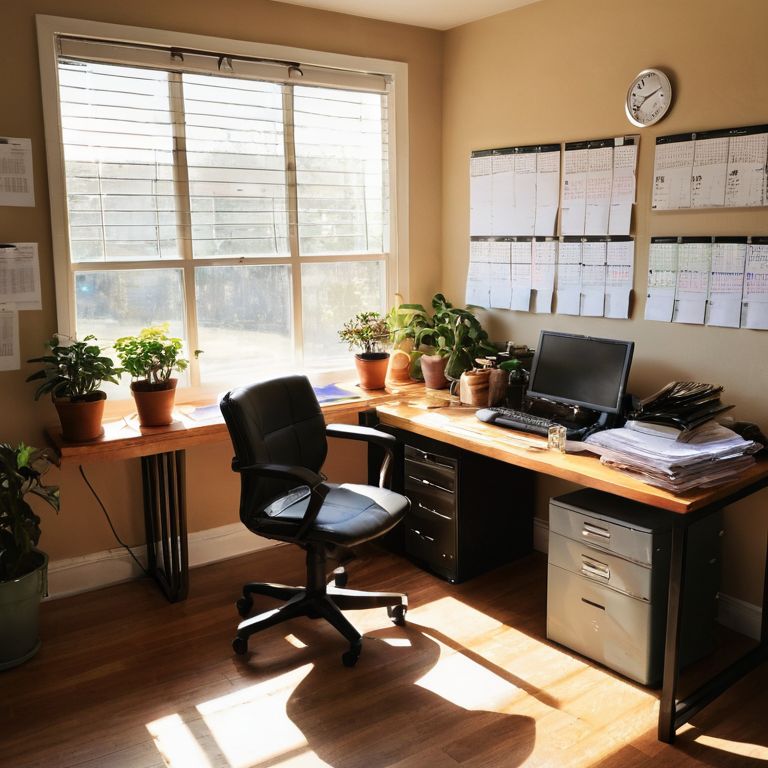As I sit in my serene home office, surrounded by the calming scent of bonsai trees and the soothing sound of ambient music, I’m reminded of the countless times I’ve helped clients tame the chaos of their tax documents. The myth that organizing tax documents has to be a daunting, tedious task is one I’m eager to debunk. In reality, learning how to organize your tax documents can be a therapeutic process that brings a sense of control and peace to your financial life. I’ve seen it time and time again – by creating a simple, logical system for your tax documents, you can breathe a sigh of relief and focus on more important things.
In this article, I’ll share my expertise as a Certified Professional Organizer to guide you through the process of organizing your tax documents with ease. You’ll learn how to create a functional and stress-free system that works for you, not against you. From sorting and categorizing to storing and maintaining your documents, I’ll provide you with practical and actionable tips to make the process as smooth as possible. By the end of this guide, you’ll be equipped with the knowledge and confidence to take control of your tax documents and enjoy the peace of mind that comes with a organized space.
Table of Contents
Guide Overview: What You'll Need

Total Time: 1 hour 30 minutes
Estimated Cost: $10 – $30
Difficulty Level: Easy
Tools Required
- Three-ring Binder (with dividers)
- Hole Punch
- Scissors
- Shredder (optional)
Supplies & Materials
- File Folders (labeled by category)
- Labels (for folders and binder)
- Storage Box (for archived documents)
Step-by-Step Instructions
- 1. First, let’s start by gathering all your tax documents from around the house and sorting them into one place. This might seem like a daunting task, but trust me, it’s a crucial step in creating a sense of control over your financial paperwork. Begin by collecting any receipts, invoices, bank statements, and tax returns, and place them in a large box or bin.
- 2. Next, separate your documents into categories, such as income, expenses, and deductions. This will make it easier to _categorize and prioritize_ your paperwork as you move forward. Use folders or labels to mark each category, and consider using color-coding to differentiate between them.
- 3. Now, let’s focus on creating a centralized filing system for your tax documents. This could be a file cabinet, a digital storage system, or even a simple folder on your desk. Choose a system that works for you and your lifestyle, and make sure it’s easily accessible.
- 4. Once you have your filing system in place, start sorting your documents into their respective folders. Be sure to _handle each document only once_ to avoid unnecessary repetition and save time. As you sort, consider implementing a “handle it now” rule, where you deal with each document immediately rather than putting it off.
- 5. As you’re sorting, take the opportunity to purge any unnecessary documents. If you have receipts or invoices that are no longer relevant, consider shredding or recycling them. This will help declutter your space and reduce the amount of paperwork you need to manage.
- 6. Now that your documents are sorted and purged, let’s talk about _creating a maintenance routine_ to keep your tax documents organized throughout the year. Set aside a specific time each week or month to review and update your files, and consider implementing a “one in, one out” policy to prevent clutter from building up again.
- 7. Finally, take a step back and admire your newly organized tax documents. Take a deep breath and enjoy the sense of accomplishment that comes with knowing your financial paperwork is in order. Remember, organizing your tax documents is not a one-time task, but rather an ongoing process that requires regular maintenance to keep your space _clutter-free and peaceful_.
Serenity Through Order

As we work on taming the tax document beast, it’s essential to remember that serenity through order is not just about having a tidy space, but also about creating a system that works for you. This is where tax document storage solutions come into play, helping you keep all your documents in one place, making it easier to access and manage them. By implementing a simple and logical system, you can reduce stress and anxiety that often comes with tax season.
To take your organization to the next level, consider organizing receipts for business expenses. This can be as simple as creating a digital folder or using a cloud storage service to keep all your receipts in one place. By doing so, you’ll be able to easily streamline tax preparation and ensure that you’re taking advantage of all the deductions you’re eligible for. This, in turn, will give you a sense of control and calm, knowing that you’re on top of your finances.
By understanding tax document retention periods, you can also make informed decisions about what to keep and what to discard, freeing up physical and mental space. This process can be therapeutic, allowing you to let go of clutter and focus on what’s truly important. As you work on creating your own digital tax folder, remember that it’s all about finding a sense of peace and tranquility in the process, and not just the end result.
Streamlining Preparation
As we delve into streamlining preparation, it’s essential to recognize that a calm and organized approach sets the tone for the entire process. By dedicating a specific time and space for preparing your tax documents, you create a sense of control and clarity. This deliberate approach allows you to focus on the task at hand, rather than feeling overwhelmed by the chaos of scattered papers and deadlines.
By implementing a simple, step-by-step system, you can transform the experience of preparing your tax documents into a therapeutic exercise in organization. This mindset shift enables you to tackle the task with a sense of purpose, rather than dread, and ultimately, find a sense of serenity in the midst of what was once a daunting task.
Taming Tax Document Chaos
As we delve into the world of tax documents, it’s essential to recognize that taming the chaos is not just about sorting papers, but about creating a sense of control. By assigning a purpose and a place to each document, we begin to weave a narrative of calm and serenity. I encourage my clients to “interview” each document, asking if it sparks joy, serves a purpose, or holds sentimental value. This mindful approach helps to clarify what’s truly important, allowing us to let go of unnecessary clutter.
By doing so, we transform the often-dreaded task of tax document organization into a therapeutic experience, one that fosters a deeper connection with our belongings and our space. As the clutter dissipates, a sense of clarity emerges, and the mind begins to mirror the newly organized environment. In this state, we can better focus on what truly matters, cultivating a sense of inner peace that permeates every aspect of our lives.
Finding Harmony in Your Financial Records: 5 Essential Tips
- Create a dedicated tax document station: Designate a specific area, like a drawer or a folder, where all tax-related documents will be stored, making it easier to find what you need when you need it
- Implement a color-coding system: Use different colored folders or labels to categorize documents by type, such as income, deductions, or receipts, to visually simplify your tax document landscape
- Set up a regular maintenance schedule: Allocate time each month to review, update, and file tax documents, preventing clutter from building up and reducing stress during tax season
- Digitize your documents: Consider scanning your tax documents and saving them to a secure, cloud-based storage service, allowing you to access them from anywhere and free up physical storage space
- Practice the ‘handle once’ rule: When dealing with a tax document, try to handle it only once by either filing it away, scanning it, or taking immediate action, reducing the likelihood of it getting lost or misplaced
Key Takeaways for a Peaceful Tax Season
By organizing your tax documents, you can transform a potentially stressful experience into a manageable and even therapeutic one, giving you a sense of control and serenity
Implementing a simple, logical system for your tax documents, such as categorizing and prioritizing, can significantly reduce anxiety and make the preparation process more efficient
Creating a dedicated space for your tax documents, whether physical or digital, and maintaining it throughout the year can help you stay on top of your financial records and enjoy a clearer, more organized mind
Finding Peace in the Details
As we bring order to our tax documents, we’re not just sorting papers – we’re sorting our thoughts, calming our minds, and creating a sanctuary from the chaos of everyday life.
Nathan Reed
Finding Peace in a Paperless World

As we’ve journeyed through the process of organizing your tax documents, you’ve learned the value of creating a serene and organized space that reflects the clarity of your mind. From setting up a simple filing system to implementing a step-by-step approach to tackling your tax paperwork, every step has been designed to bring you closer to a sense of calm and control. By streamlining your preparation and taming the tax document chaos, you’ve not only reduced stress but also created a system that will serve you well in the years to come.
Now, as you stand in your newly organized space, surrounded by the quiet confidence that comes with knowing exactly where everything is and why, remember that organizing your tax documents is just the beginning. It’s a gateway to a lifestyle where every object has a purpose or a place, and every moment spent in your home is a testament to the peace and serenity that awaits you within. May your journey towards a more organized, more peaceful you continue to unfold with each passing day, and may the serenity you’ve found in your tax documents be just the start of a more harmonious, clutter-free life.
Frequently Asked Questions
What's the best way to categorize and prioritize my tax documents so I can easily find what I need?
Let’s simplify this – I recommend categorizing your tax documents into clear groups, such as income, deductions, and receipts, and then prioritize them by urgency and frequency of use, so you can quickly find what you need and breathe a sigh of relief.
How often should I review and update my tax document organization system to ensure it stays effective?
I recommend reviewing your tax document system quarterly, and doing a thorough update annually. This ensures it stays tailored to your changing needs and remains a source of calm, not stress. Regular check-ins help maintain the serenity that comes with a well-organized space, and prevent clutter from creeping back in.
What are some common mistakes people make when organizing their tax documents that I can avoid to save time and reduce stress?
Let’s avoid some common pitfalls. Many people misfile or mislabel documents, or worse, miss crucial ones altogether. Others procrastinate, leading to last-minute scrambles. To sidestep these stressors, take a few moments to review and categorize your documents as you go, and set aside a specific time each week to maintain your system.
